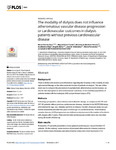Mostrar o rexistro simple do ítem
The modality of dialysis does not influence atheromatous vascular disease progression or cardiovascular outcomes in dialysis patients without previous cardiovascular disease
| dc.contributor.author | Borrás Sans, Mercé | |
| dc.contributor.author | Pérez-Fontán, Miguel | |
| dc.contributor.author | Martínez-Alonso, Monserrat | |
| dc.contributor.author | Bajo, Auxiliadora | |
| dc.contributor.author | Betriu, Angels | |
| dc.contributor.author | Valdivielso, José Manuel | |
| dc.contributor.author | Fernández, Elvira | |
| dc.date.accessioned | 2018-12-10T11:53:55Z | |
| dc.date.available | 2018-12-10T11:53:55Z | |
| dc.date.issued | 2017-11-02 | |
| dc.identifier.citation | Borrás Sans M, Pérez-Fontán M, Martínez-Alonso M, Bajo A, Beltriu A, Valdivieso JM, et al. The modality of dialysis does not influence atheromatous vascular disease progression or cardiovascular outcomes in dialysis patients without previous cardiovascular disease. PLOS One. 2017;12(11):e0186921 | es_ES |
| dc.identifier.issn | 1932-6203 | |
| dc.identifier.uri | http://hdl.handle.net/2183/21481 | |
| dc.description.abstract | [Abstract] Background. There is limited and inconclusive information regarding the influence of the modality of renal replacement therapy on the atherosclerotic burden of patients on dialysis. The aim of this study was to compare the prevalence of asymptomatic atheromatous carotid disease, as also its rate of progression and cardiovascular outcomes, in two matched populations of patients treated with hemodialysis (HD) and peritoneal dialysis (PD). Methods. Following a prospective, observational and multicenter design, we compared 237 PD and 237 HD patients without previous cardiovascular disease, included in the NEFRONA study, and matched for age, sex, diabetes and time on dialysis. Carotid ultrasound study was performed at baseline and after two years of follow-up in 6 carotid territories. Atheromatous vascular disease (AVD) progression was defined as any increase in the number of territories with plaques after 2 years. Fatal and non fatal cardiovascular events were also recorded during 36-month of follow-up. Main results. At baseline, PD patients presented a worse general cardiovascular risk profile than HD patients. On the contrary, some markers of prevalent atherosclerotic disease (common carotid intima-media thickness and ankle-brachial index) were more favorable in PD patients. During follow-up, we observed no differences either in the rate of progression of atheromatous vascular disease (OR 1.78, 95% CI 0.80–4.06, p = 0.161) or in the incidence of cardiovascular events (OR 1.51, 95% CI 0.85–2.66, p = 0.159), according to the modality of dialysis. Conclusion. Dialysis modality did not impact on atherosclerotic carotid disease progression or cardiovascular outcomes, in two groups of patients treated with PD or HD. | es_ES |
| dc.language.iso | eng | es_ES |
| dc.publisher | PLOS | es_ES |
| dc.relation.uri | https://doi.org/10.1371/journal.pone.0186921 | es_ES |
| dc.rights | Creative Commons Attribution 4.0 International License (CC-BY 4.0) | es_ES |
| dc.rights.uri | http://creativecommons.org/licenses/by/4.0/ | * |
| dc.subject | Atherosclerosis | es_ES |
| dc.subject | Cardiovascular diseases | es_ES |
| dc.subject | Carotid arteries | es_ES |
| dc.subject | Disease progression | es_ES |
| dc.subject | Prospective studies | es_ES |
| dc.subject | Renal dialysis | es_ES |
| dc.subject | Survival analysis | es_ES |
| dc.title | The modality of dialysis does not influence atheromatous vascular disease progression or cardiovascular outcomes in dialysis patients without previous cardiovascular disease | es_ES |
| dc.type | info:eu-repo/semantics/article | es_ES |
| dc.rights.access | info:eu-repo/semantics/openAccess | es_ES |
| UDC.journalTitle | PLOS one | es_ES |
| UDC.volume | 12 | es_ES |
| UDC.issue | 11 | es_ES |
| UDC.startPage | e0186921 | es_ES |
Ficheiros no ítem
Este ítem aparece na(s) seguinte(s) colección(s)
-
GI-FENM - Artigos [119]







